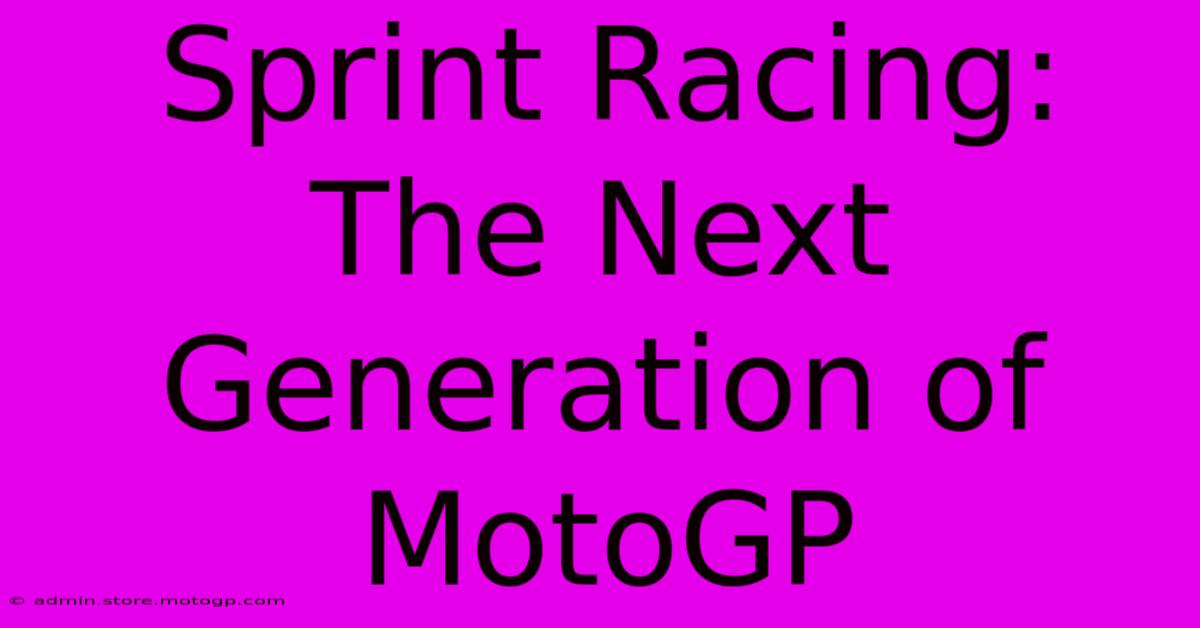Sprint Racing: The Next Generation Of MotoGP

Table of Contents
Sprint Racing: The Next Generation of MotoGP
MotoGP, the pinnacle of motorcycle racing, is constantly evolving. In a bid to increase excitement and attract a wider audience, the sport has introduced a significant change: Sprint races. This addition isn't just a minor tweak; it's reshaping the weekend format and injecting a new level of intensity into the championship. This article delves into the impact of sprint races on MotoGP, exploring the benefits, drawbacks, and what the future holds for this thrilling new addition.
The Sprint Race Format: A Quick Overview
Sprint races, typically held on Saturday afternoon, are shorter than the main Grand Prix races, usually around a third of the distance. They award points to the top nine finishers, albeit fewer than the main race, significantly altering the championship standings and adding a crucial layer of strategic complexity. These races are not merely warm-up sessions; they are high-stakes events with their own unique challenges and rewards.
How Sprint Races Shake Up the Weekend
The introduction of sprint races has completely transformed the MotoGP weekend schedule. Friday's free practice sessions are still crucial for setup, but Saturday now becomes a whirlwind of activity. The qualifying session remains, but its importance has shifted. While pole position still holds prestige, the sprint race outcome now heavily influences grid positions for Sunday's main Grand Prix. This creates a captivating dynamic where riders must balance the risk of pushing too hard in the sprint with the need to conserve their machinery for the longer, more points-rich race.
Benefits of Sprint Races: Increased Excitement and Engagement
The impact of sprint races on MotoGP is undeniable. The benefits are clear:
- Increased Viewership: The additional race provides more viewing opportunities for fans, boosting television ratings and online engagement. The shorter race format is also more accessible to casual viewers, who might find the length of a traditional Grand Prix race daunting.
- Enhanced Competition: The shortened distance means less time for strategy and more emphasis on raw speed and overtaking, leading to more aggressive racing and increased overtaking opportunities. This heightened competition adds immense excitement for both spectators and participants.
- Championship Dynamics: The awarding of points significantly impacts the championship standings. A strong sprint race performance can provide a crucial boost, while a poor showing can significantly hinder a rider's chances. This makes every session count and keeps the competition alive.
- Strategic Depth: Teams and riders now face complex strategic decisions. Should they prioritize the sprint race, potentially risking damage to their bike, or focus on the main Grand Prix? This added layer of strategic depth enhances the intellectual challenge of the sport.
Potential Drawbacks: Tire Wear and Rider Fatigue
While the sprint races are a major success, some potential drawbacks exist:
- Increased Tire Wear: The extra race puts additional strain on tires, potentially leading to more tire-related issues during the main Grand Prix. Teams must carefully manage tire selection and usage to optimize performance across both races.
- Rider Fatigue: The added exertion from the sprint race could lead to increased rider fatigue during the main event. This is a critical factor, as rider fitness and stamina are paramount in the demanding world of MotoGP.
- Cost Implications: The extra race undoubtedly adds to the overall cost of the sport, from tire consumption to logistical requirements.
The Future of Sprint Races in MotoGP
The future of sprint races in MotoGP appears bright. The initial results suggest that they have been a success, increasing fan engagement and adding an extra layer of excitement to the sport. While some challenges remain, modifications and adjustments can be made to mitigate the potential drawbacks. We can expect to see further refinements in the format, with a continued focus on finding the optimal balance between excitement and sustainability. Sprint races are not just a temporary addition; they are a significant step forward in shaping the next generation of MotoGP.
Conclusion: A Thrilling Addition to the Sport
The introduction of sprint races has undeniably revitalized MotoGP. They have amplified the excitement, increased fan engagement, and brought a new strategic dimension to the sport. While the challenges need careful management, the benefits far outweigh the drawbacks, ensuring that sprint races are here to stay and will continue to shape the future of this exhilarating motorsport.

Thank you for visiting our website wich cover about Sprint Racing: The Next Generation Of MotoGP. We hope the information provided has been useful to you. Feel free to contact us if you have any questions or need further assistance. See you next time and dont miss to bookmark.
Featured Posts
-
Moto2 Specs Designed For Adrenaline
Feb 20, 2025
-
The Best Motorcyclist A Cut Above The Rest
Feb 20, 2025
-
Moto Gp Streams A Tribute To The Greatest Moto Gp Riders Of All Time
Feb 20, 2025
-
How To Choose A Genuine Helmet Stay Safe On Your Bike
Feb 20, 2025
-
Moto2 The Championship That Keeps You On The Edge Of Your Seat
Feb 20, 2025
